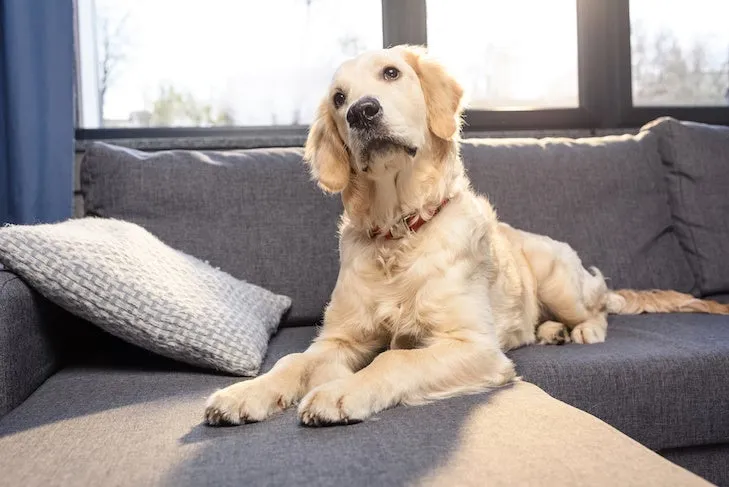Having a dog who rushes out the door the moment it opens can be a stressful and dangerous situation. This common behavior, known as “door darting,” puts your beloved companion at risk of getting lost, hit by a car, or encountering conflicts with other animals or people. Fortunately, with consistent training and patience, you can teach your dog alternative behaviors that ensure their safety and bring peace of mind to your household. Understanding How To Stop A Dog From Darting Out The Door is crucial for any responsible pet owner. Should your dog ever manage to slip past you, knowing how to train a puppy to come on command can be a life-saving skill.
Using Management Tools in the Meantime
While dedicated training is the most effective long-term solution to prevent door darting, it takes time and consistency. In the interim, employing management tools can significantly enhance your dog’s safety. The simplest approach involves keeping your dog leashed when you anticipate opening the door, whether to greet visitors or accept a delivery. This physical restraint immediately prevents them from rushing out.
Additionally, strategically placed dog gates or portable exercise pens can create a vital barrier in front of your doorway. These tools are excellent for establishing a safe zone, preventing your dog from even reaching the door when it’s opened. For some dog owners, a combination of these management techniques may become a permanent and effective solution to prevent door darting altogether. Remember, don’t hesitate to utilize these barriers, closed doors, and leashes as necessary to manage your dog’s behavior and keep them safe.
 Beagle sitting calmly in its open crate
Beagle sitting calmly in its open crate
Training Your Dog for Polite Exits
Many dogs try to dart out the door when they know it’s time for a walk. To counteract this, we aim to teach them polite door manners, emphasizing that you, the handler, should always exit through doorways first. This structured approach helps in mastering how to get my dog to go outside calmly and safely.
Step 1: Leash and Attention Inside. Begin by putting your dog’s leash on while still inside the house. Use plenty of praise and high-value treats to reward your dog for staying engaged with you as you prepare to leave, gathering your keys, wallet, or anything else needed for going outside. The goal here is to build a positive association with the pre-exit routine, diverting their focus from the door itself.
Step 2: Stationary Position at the Door. Ask your dog to sit or lie down next to you, a short distance from the door. Praise and reward them generously for holding this position. Then, slowly reach towards the door. If your dog remains in their sit or down, continue praising and rewarding. The objective at this stage is to solidify a stationary position near the door, teaching them self-control in anticipation of the door opening. If your dog breaks position, calmly reset them and repeat.
Step 3: Unlocking and Opening the Door. Once your dog can consistently maintain their sit or down position as you reach for the door, the next step is to unlock and then slightly open it. As you do this, continue to praise and treat your dog for staying put. Immediately close the door, offering more praise and treats. This teaches them that a slightly open door doesn’t automatically mean freedom to bolt.
Step 4: Stepping Through the Doorway. Now that your dog is reliably holding their sit or down as the door opens, it’s time for you to step through it. Give your dog a treat the moment you step out. Praise them, then step back inside, close the door, and reward them again. This reinforces the idea that your exit doesn’t necessarily mean theirs and that staying yields rewards.
Step 5: The Release Cue. Your dog can now patiently wait while you open the door and step through. For the final stage, after you’ve opened the door and stepped out, this time, instead of immediately returning, give your dog their designated release cue (e.g., “Okay” or “Free”). Praise and treat them as they calmly follow you through the doorway. This teaches them to wait for permission before exiting, solidifying their understanding of polite door manners.
 Golden Retriever lying calmly on a sofa indoors
Golden Retriever lying calmly on a sofa indoors
Avoiding Door Darting When the Doorbell Rings
Door darting isn’t only an issue when you’re leaving; it can also occur when your dog becomes overexcited by the sound of the doorbell or a knock. In these scenarios, teaching your dog an alternative, calm behavior away from the entrance is key to preventing them from rushing the door. This can also help mitigate behaviors like how to train my dog to stop jumping on people when visitors arrive.
Place Training
“Place” training is an excellent method where you teach your dog to go to a designated spot, like their bed or a mat, and remain there until released. This provides a clear, desirable behavior for them to perform when the doorbell rings, keeping them safely away from the door.
Step 1: Introduce the “Place” Cue. Have a helper ring your doorbell or play a recording of a doorbell sound. The moment your dog reacts, grab their attention with a treat and lure them to their designated “place” (e.g., a dog bed in a nearby, calm area). Once on the bed, cue them into a down position. If your dog knows “stay,” add that cue as well.
Step 2: Reinforce “Stay” on Place. Praise and toss treats to your dog as you slowly move away from the bed. If your dog leaves their place, calmly guide them back to it without fuss. Continue to reward them with treats only when they are on their bed. Gradually increase your distance and the duration they stay on their place.
Step 3: Greeting Visitors While Dog Stays. As your dog’s understanding of staying on their bed improves, you’ll be able to approach the door, greet visitors, or collect deliveries while your dog remains calmly in their place. Continue to offer praise, and if possible, toss treats to them from a distance to reinforce the desired behavior.
Step 4: Release and Reward. After you’ve finished at the door, return to your dog’s place. Praise and treat them, then give their release cue. This signals the end of their “place” command.
Step 5: Build Automaticity. With consistent practice, your dog will begin to associate the doorbell with the cue to go directly to their place without needing to be lured. Continue to praise and reward them for this proactive behavior, reinforcing that calm responses lead to positive outcomes.
Go to a Safe Space
Another effective strategy to prevent door darting when the doorbell rings is to teach your dog to automatically retreat to a designated safe space in a different area of the house. This area, such as a crate or a specific room, should be a place where they feel comfortable and will be rewarded.
Step 1: Identify Your Safe Space. Choose a location away from the front door where you want your dog to go when the doorbell rings. This could be their crate, a spare bedroom, or a laundry room – any contained area where they can be secured comfortably.
Step 2: Create a Positive Association with the Sound. Have a helper press the doorbell, or play the sound. Immediately get your dog’s attention with a treat, then enthusiastically run towards the designated safe area, encouraging your dog to follow. Praise them excitedly for coming with you. Once in the safe space, toss or scatter a handful of treats, then secure your dog behind a door or baby gate before you go to answer the front door.
Step 3: Reinforce the Safe Space. Repeat Step 2 over multiple training sessions. Each time your dog reaches the safe space, provide them with a high-value, longer-lasting treat like a chew. This keeps them occupied and helps them build a strong, positive association with going to that area.
Step 4: Maintain Consistency. Continue practicing this game regularly. Keeping treats or chews readily accessible near the safe space allows you to reward your dog immediately once they move away from the front door. This quick reinforcement is crucial for solidifying the new behavior.
Step 5: Establish the Automatic Response. With enough repetition, your dog will learn to associate the doorbell sound with the cue to run to their designated waiting area, eventually doing so independently. There, they will eagerly anticipate their rewards while you calmly attend to visitors or deliveries, completely eliminating the door darting behavior.
Teaching your dog alternatives to door darting not only keeps them safe from dangerous situations but also strengthens their understanding of essential commands like “go to place,” “stay,” “sit,” “lie down,” and “release.” If your dog already knows these basic commands, applying them to door manners will be even easier and more effective, fostering a well-behaved and secure pet.
